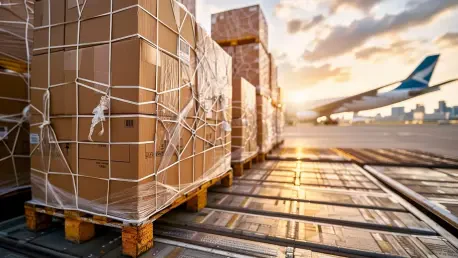In today’s rapidly evolving geopolitical and business environment, the airline industry is at the forefront of a complex terrain where e-commerce is a driving force. The recent easing of the US-China trade war has offered some respite, yet it remains far from restoring pre-tariff e-commerce volumes. Particularly impacted are non-postal packages, which continue to face significant levies. This creates both opportunities and challenges for airlines aiming to assert themselves as leaders in the e-commerce airfreight sector.
Overview of the Airline Industry in the E-Commerce Landscape
The airline industry is increasingly integral to the e-commerce ecosystem, largely due to its critical role in facilitating global trade and logistics. As e-commerce continues to grow, airlines are adopting advanced technologies and strategies to cater to expanding consumer demands and international market needs. Notably, several major carriers enjoy an edge over traditional integrators by leveraging their extensive flight networks to tap into premium service offerings. This includes services with advanced logistics technology such as parcel-level tracking and door-to-door delivery solutions.
Airlines are also maneuvering through significant regulatory landscapes that come with managing and transporting e-commerce goods. Service providers face the dual challenge of enhancing operational gains while adhering to security and compliance standards. Market players are increasingly focusing on technological transformations to streamline efficiencies, thus improving their competitive stance amidst evolving industry regulations.
Trends and Opportunities in the E-Commerce Airfreight Sector
Key Industry Trends Transforming E-Commerce Airfreight
Technological advancements are revolutionizing the way airlines operate within the e-commerce airfreight market. The shift in consumer behaviors, increasingly toward online retail, demands more agile and adaptive logistics solutions from airlines. Further, there is a strong push toward integrating end-to-end logistics technologies that offer seamless transitions between various stages of package delivery, including first and last-mile logistics.
This innovation-driven environment provides airlines with multiple opportunities to enhance their offerings. There is immense potential in enlisting logistics partners to provide end-to-end solutions, thus capturing greater market share and improving profit margins beyond basic parcel aggregations.
Market Data and Growth Projections
Current market data underscores robust growth within the e-commerce airfreight sector, reflecting a rising trajectory fueled by global trade dynamics and consumer demands for expedited deliveries. Airlines are positioned to contribute significantly to this growth curve, with projections indicating increased freight volumes despite existing tariffs and trade policy shifts.
Future forecasts indicate that as barriers reduce incrementally, airlines will play a larger role in servicing global e-commerce needs, driven by innovative practices and enhanced capabilities. This progression points to expanded market size and operational efficiencies for those aligning their strategies proactively with market demands.
Challenges Facing Airlines in the E-Commerce Era
Airlines face a set of formidable challenges in the e-commerce space, driven by technological, regulatory, and market dynamics. The need for advanced analytical tools and logistics infrastructures imposes a burden on airlines to consistently innovate. Furthermore, regulatory compliance, particularly around international trade and customs, adds another layer of complexity.
To overcome these obstacles, airlines need to adopt strategic partnerships with technology and logistics providers. Developing competencies in advanced analytics, leveraging data-driven insights, and implementing scalable solutions are essential strategies that can position airlines as resilient, forward-thinking players in the rapidly changing market.
Regulatory Environment and its Impact on E-Commerce Airfreight
Changes in international trade policies, security measures, and compliance standards significantly impact the airline industry’s participation in e-commerce. With heightened scrutiny on customs and tariffs, airlines are compelled to navigate a regulatory landscape that demands both agility and stringent adherence to laws.
Compliance with these laws ensures ongoing operations but also shapes how airlines can innovate within the market’s confines. By investing in security and regulatory technologies, airlines can solidify their place as safe, compliant, and efficient facilitators of global e-commerce.
The Future of Airlines in E-Commerce: Innovations and Growth
Innovation remains central to the future direction of airlines in the e-commerce sector. Disruptors like digital logistics platforms, artificial intelligence, and blockchain technologies are set to redefine how airlines manage supply chains and customer interactions. As consumer preferences evolve, airlines must remain proactive to anticipate and meet the shifting demands.
Projected growth areas emphasize comprehensive logistics solutions, where airlines can capitalize on their networks and new technologies to expand their e-commerce service offerings. Such growth is informed by global economic conditions, where evolving demands create opportunities for efficiency and expanded capacities.
Conclusion and Recommendations
The analysis confirms that while airlines face significant challenges in the e-commerce landscape, they also enjoy a multitude of opportunities to innovate and grow. The focus should be on adopting scalable technologies and forming strategic alliances within the logistics arena to unlock increased market potential. Airlines are encouraged to invest in infrastructure that supports comprehensive logistics solutions, enhancing service delivery while maintaining compliance and security. Looking ahead, the landscape appears promising for airlines ready to adapt and navigate these e-commerce waves effectively, fostering new heights in industry advancements and growth.









